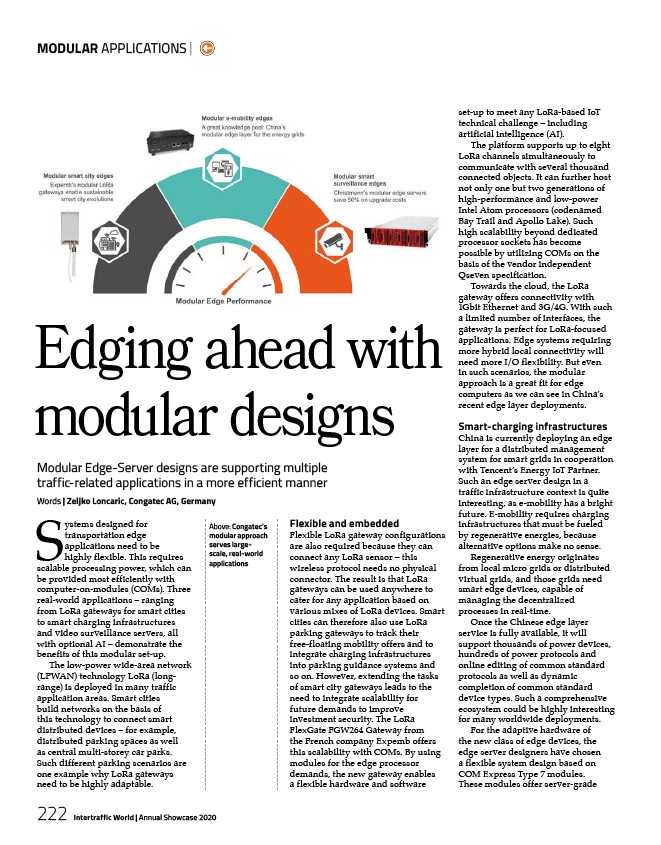
MODULAR APPLICATIONS |
Modular Edge-Server designs are supporting multiple
traffic-related applications in a more efficient manner
Words | Zeljko Loncaric, Congatec AG, Germany
applications Systems designed for
Above: Congatec’s
modular approach
serves largescale,
222 Intertraffic World | Annual Showcase 2020
real-world
transportation edge
applications need to be
highly flexible. This requires
scalable processing power, which can
be provided most efficiently with
computer-on-modules (COMs). Three
real-world applications – ranging
from LoRa gateways for smart cities
to smart charging infrastructures
and video surveillance servers, all
with optional AI – demonstrate the
benefits of this modular set-up.
The low-power wide-area network
(LPWAN) technology LoRa (longrange)
is deployed in many traffic
application areas. Smart cities
build networks on the basis of
this technology to connect smart
distributed devices – for example,
distributed parking spaces as well
as central multi-storey car parks.
Such different parking scenarios are
one example why LoRa gateways
need to be highly adaptable.
Flexible and embedded
Flexible LoRa gateway configurations
are also required because they can
connect any LoRa sensor – this
wireless protocol needs no physical
connector. The result is that LoRa
gateways can be used anywhere to
cater for any application based on
various mixes of LoRa devices. Smart
cities can therefore also use LoRa
parking gateways to track their
free-floating mobility offers and to
integrate charging infrastructures
into parking guidance systems and
so on. However, extending the tasks
of smart city gateways leads to the
need to integrate scalability for
future demands to improve
investment security. The LoRa
FlexGate FGW264 Gateway from
the French company Expemb offers
this scalability with COMs. By using
modules for the edge processor
demands, the new gateway enables
a flexible hardware and software
set-up to meet any LoRa-based IoT
technical challenge – including
artificial intelligence (AI).
The platform supports up to eight
LoRa channels simultaneously to
communicate with several thousand
connected objects. It can further host
not only one but two generations of
high-performance and low-power
Intel Atom processors (codenamed
Bay Trail and Apollo Lake). Such
high scalability beyond dedicated
processor sockets has become
possible by utilizing COMs on the
basis of the vendor independent
Qseven specification.
Towards the cloud, the LoRa
gateway offers connectivity with
1Gbit Ethernet and 3G/4G. With such
a limited number of interfaces, the
gateway is perfect for LoRa-focused
applications. Edge systems requiring
more hybrid local connectivity will
need more I/O flexibility. But even
in such scenarios, the modular
approach is a great fit for edge
computers as we can see in China’s
recent edge layer deployments.
Smart-charging infrastructures
China is currently deploying an edge
layer for a distributed management
system for smart grids in cooperation
with Tencent’s Energy IoT Partner.
Such an edge server design in a
traffic infrastructure context is quite
interesting, as e-mobility has a bright
future. E-mobility requires charging
infrastructures that must be fueled
by regenerative energies, because
alternative options make no sense.
Regenerative energy originates
from local micro grids or distributed
virtual grids, and those grids need
smart edge devices, capable of
managing the decentralized
processes in real-time.
Once the Chinese edge layer
service is fully available, it will
support thousands of power devices,
hundreds of power protocols and
online editing of common standard
protocols as well as dynamic
completion of common standard
device types. Such a comprehensive
ecosystem could be highly interesting
for many worldwide deployments.
For the adaptive hardware of
the new class of edge devices, the
edge server designers have chosen
a flexible system design based on
COM Express Type 7 modules.
These modules offer server-grade
Edging ahead with
modular designs